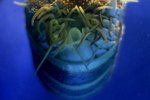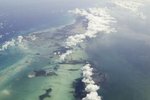
Sponges (porifera) are some of the simplest animals in the ocean. With no tissues or organs, they're simply collections of cells arranged in various structures that capture nutrients passing through their pores. At least, most of them are. Carnivorous sponges can catch live food rather than just eat whatever happens by.
What Sponges Eat
Most sponges are detritivores -- they eat organic debris particles and microscopic life forms that they filter out of ocean water. They're not picky eaters; whatever the ocean current carries their way is what they feast on. Sponges can digest large particles and tiny organisms for sustenance. Sponges typically grow on or near coral reefs -- plenty of nutrient-rich particles on which to feed exist with so many other life forms around.
How Sponges Eat
Sponges draw water through their pores, filter particles for consumption, then eject the water from their bodies. The sponge's eating mechanism depends on collar cells. Each cell has a sticky funnel-shaped collar and a flagellum, a thin whiplike structure. The flagella sway, drawing water through the cell, and the sticky collar collects particles of nutrients and oxygen. At the same time the flagella eliminate waste, carbon dioxide and excess water. Amebocyte cells carry the nutrients to the sponge's other cells. Because every surface of the sponge's body is able to carry out this process, the sponge is a highly effective filter feeder.
Encrusting Sponges

Although not scientifically classified so, sponges exist into two basic groups based on body structure: encrusting and free-standing. Encrusting sponges have amorphous bodies. They cling to surfaces like rock and other hard surfaces, where a carpetlike layer forms on them. Encrusting sponges make complicated webs to filter nutrients out of the water, spreading like moss over surfaces.
Free-Standing Sponges

Free-standing sponges are more complicated body forms than encrusting sponges. They can develop in a variety of shapes, like tall tubes and cupped vases. The largest free-standing sponges are barrel sponges, which can stand taller than 6 feet. Sponges can grow this big only when enough food exists in the environment to support such large bodies. Barrel sponges often grow in deep waters rich with ocean life.
Carnivorous Sponges
In the deep sea, the sponge diet is different. The harp sponge (Chondrocladia lyra) is the first species of carnivorous sponge identified by marine researchers, about 20 years ago. Harp sponges are known to have between two and six vanes radiating out from a center -- those with more vanes may exist. Each vane has vertical branches lined with hooks. The hooks on the sponge's arms catch tiny shrimp when ocean currents push the crustaceans the sponge's way. Once a sponge has caught an animal, the sponge envelops it in a membrane and begins to slowly digest it. Harp sponges live around 11,000 feet deep on the ocean floor. Chondrocladia lampadiglobus, the ping pong tree sponge, is another recently discovered carnivorous sponge.
References
- Monterey Bay Aquarium Research Institute: Scientists Discover Extraordinary New Carnivorous Sponge
- The Wonders of the Seas: Sponges: They Are Nothing Like Sponge Bob!
- SEA and SKY: Sponges & Sea Squirts
- American Scientist: At Home in the Dark
- University of California Museum of Paleontology: Introduction to Porifera
Resources
Photo Credits
-
Comstock/Comstock/Getty Images
Writer Bio
Madeline Masters works as a dog walker and professional writer. In the past she has worked as a fitness columnist, fundraising copywriter and news reporter. Masters won two Pennsylvania Newspaper Association Awards in 2009. She graduated from Elizabethtown College with a Bachelor of Arts in English.




